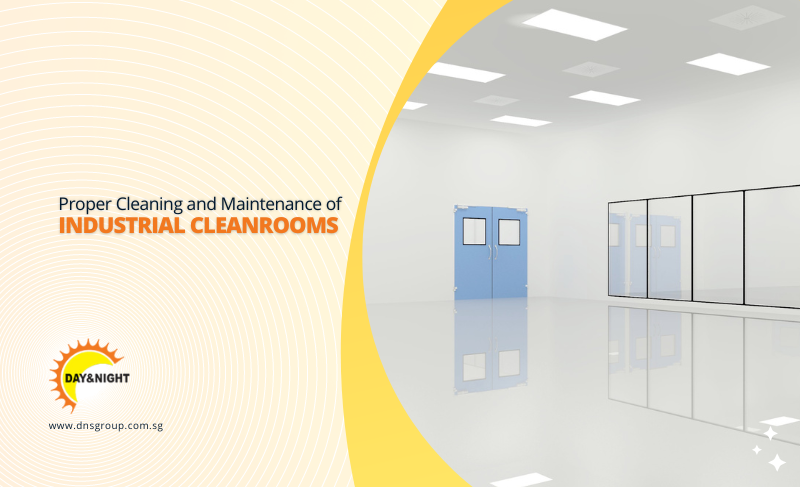Proper Cleaning and Maintenance of Industrial Cleanrooms

The utilisation of cleanrooms is becoming more crucial as products get smaller and more sensitive to dust, vapours, and other airborne particles. The challenge here is to keep equipment running while improving cleanliness and reducing contamination. This article will discuss what you need to know about industrial cleanrooms and how to clean and maintain them properly.
What is a Cleanroom?
A cleanroom is a specifically engineered enclosed area within a manufacturing or research facility. Cleanrooms make it possible to precisely regulate, monitor, and maintain an internal environment. Cleanrooms were primarily employed to contain biological threats or reduce contamination caused by dust, vapours, germs, fibres, and skin flakes. However, they are now frequently used to regulate other elements, including:
- Airflow
- Filtration
- Humidity
- Pressure
- Temperature
How Cleanrooms Get Contaminated
The following are components or elements that can compromise a cleanroom, increasing the risk of contamination:
- Personnel
Personnel makes up between 75% to 80% of the particles discovered during cleanroom inspections, making them the biggest threat to an industrial cleanroom. They introduce particles like hair, oil skin flakes, and yeast while carrying external particles from perfume, cosmetics, lotion, and clothing material (lint, fibres).
- Manufacturing equipment
These equipment generate gas, emissions, lubricants, and airborne particles. This is why all the materials used in their composition must be evaluated and Material Safe Data Sheet (MSDS)-approved. Specialty cleaning and properties are required for safe cleaning, including sterilisation and examination, antistatic characteristics, specific conductivity material, out-gassing properties, and antimicrobial aspects.
- Tools
Contaminants can originate from common tools, such as cleaning products (mops and brooms) or writing supplies (pen and paper). Objects inside the cleanroom must only be cleaned with approved cleaning tools and equipment, such as cleanroom vacuums and non-particulating wipes and mops. Electronic documentation, approved cleanroom paper, and special writing materials should also be used to reduce the risk of contamination.
- Raw materials and products
Products can produce cleanroom debris, glass flakes, and aluminium particles from vial caps. The scope of cleaning depends on the class of the cleanroom, the destination of the material or product, and the likelihood of cross-contamination with other processes.
Preventive Measures to Reduce Contamination Risk
The best way to keep it clean is to follow proper sanitation techniques like washing and drying your hands completely, following the correct gowning procedure for your ISO class, using sterile gloves (instead of powdered gloves), and ensuring all employees have access to tools and garments that fit them.
Cleaning Your Cleanroom
It takes diligent commitment to daily and weekly cleaning duties to keep your workspace clean and sanitised. More rigorous objectives may need to be introduced, or these tasks may need to be finished more regularly, depending on the strictness of your class standard. Whatever your facility requires, establish a cleaning schedule that outlines all tasks and makes them simple to understand and carry out. The general cleaning guidelines suggested for all cleanroom requirements are listed below.
DAILY CLEANING
- Before the work shift starts, use a damp mop on the floors and vacuum to dry them.
- Vacuum the walls using a HEPA filter vacuum.
- Wash and wipe dry all your windows and pass-throughs.
- Wipe all work areas at the end of every shift (more frequently for cleanrooms with high-class standards).
- Put away supplies and products between shifts to avoid further contamination.
WEEKLY CLEANING
- Clean the floors with a cleanroom-specific detergent, distilled water, and HEPA filter vacuum.
- Wipe the walls with a damp sponge and distilled water. Then, vacuum dry.
AS NEEDED
- The ceiling should be cleaned with detergent and distilled water to remove any residue.
- Wipe off all light lenses using a damp sponge.
- Replace sticky mats once you notice wear.
Keep in mind that your cleanroom may have specialised cleaning requirements. You can improve your cleanroom’s capacity to serve you if you strive to adhere to methodical cleaning practices.
Steps to Cleanroom Maintenance
Aside from regular cleaning as part of the cleanroom maintenance, ensure that these additional steps are taken to ensure high-quality production and testing conditions:
- Use a polycarbonate shield when lubricating equipment to prevent the lubricant from contaminating the space.
- Maintain positive-pressure airflow before, during, and after the cleaning tasks.
- Keep detailed records of the acceptable contamination margins and the cleanroom’s adherence to cleanliness standards.
- Ensure that your workers have the necessary gloves, gowns, shoe covers, and other shielding materials to minimise contamination during cleaning.
- Create comprehensive plans and assign responsibility for every cleaning task to keep your cleanroom compliant with cleanliness standards.
Conclusion
Industrial cleanrooms require regular sanitation and maintenance to use them optimally for your business operations while being compliant with the industry’s cleanliness standards. At Day&Night Services, we implement an appropriate cleanroom cleaning and maintenance program for your cleanrooms, guaranteeing a pollutant-free space.
Recent Articles
Categories
- Cleanroom Cleaning (1)
- Commercial Cleaning Services (20)
- Commercial Kitchen Cleaning (2)
- Disinfection Cleaning Services (1)
- Disinfection Services Singapore (2)
- Floor Cleaning Services (2)
- Home Cleaning Services (1)
- House Cleaning Services (1)
- Industrial Cleaning Services (15)
- Kitchen Cleaning Services (4)
- Office Cleaning Services (19)
- Pest Control Services (2)
Get in touch with our cleaning team today for a quote.

Enquire Here
Kindly leave your details below and we will contact you back shortly. Thank You!







